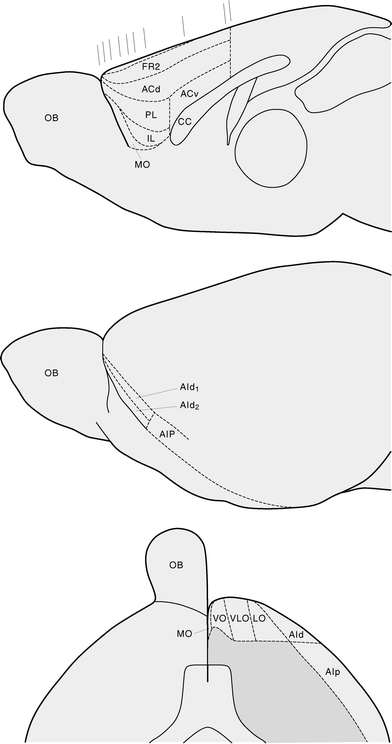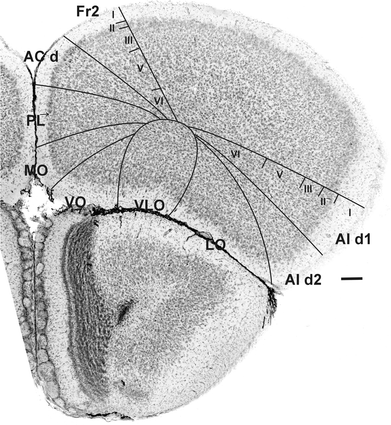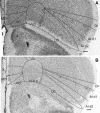Cytoarchitectonic and chemoarchitectonic characterization of the prefrontal cortical areas in the mouse
- PMID: 20221886
- PMCID: PMC2862954
- DOI: 10.1007/s00429-010-0247-z
Cytoarchitectonic and chemoarchitectonic characterization of the prefrontal cortical areas in the mouse
Abstract
This study describes cytoarchitectonic criteria to define the prefrontal cortical areas in the mouse brain (C57BL/6 strain). Currently, well-illustrated mouse brain stereotaxic atlases are available, which, however, do not provide a description of the distinctive cytoarchitectonic characteristics of individual prefrontal areas. Such a description is of importance for stereological, neuronal tracing, and physiological, molecular and neuroimaging studies in which a precise parcellation of the prefrontal cortex (PFC) is required. The present study describes and illustrates: the medial prefrontal areas, i.e., the infralimbic, prelimbic, dorsal and ventral anterior cingulate and Fr2 area; areas of the lateral PFC, i.e., the dorsal agranular insular cortical areas and areas of the ventral PFC, i.e., the lateral, ventrolateral, ventral and medial orbital areas. Each cytoarchitectonically defined boundary is corroborated by one or more chemoarchitectonic stainings, i.e., acetylcholine esterase, SMI32, SMI311, dopamine, parvalbumin, calbindin and myelin staining.
Figures















Similar articles
-
The rat orbital and agranular insular prefrontal cortical areas: a cytoarchitectonic and chemoarchitectonic study.Brain Struct Funct. 2008 Feb;212(5):387-401. doi: 10.1007/s00429-007-0164-y. Epub 2008 Jan 9. Brain Struct Funct. 2008. PMID: 18183420
-
Orbitomedial prefrontal cortical projections to distinct longitudinal columns of the periaqueductal gray in the rat.J Comp Neurol. 2000 Jul 10;422(4):556-78. doi: 10.1002/1096-9861(20000710)422:4<556::aid-cne6>3.0.co;2-u. J Comp Neurol. 2000. PMID: 10861526
-
Parvalbumin-, calbindin-, and calretinin-immunoreactive neurons in the prefrontal cortex of the owl monkey (Aotus trivirgatus): a standardized quantitative comparison with sensory and motor areas.Brain Behav Evol. 2003;62(1):19-30. doi: 10.1159/000071957. Brain Behav Evol. 2003. PMID: 12907857
-
Comparison of (stereotactic) parcellations in mouse prefrontal cortex.Brain Struct Funct. 2014 Mar;219(2):433-59. doi: 10.1007/s00429-013-0630-7. Epub 2013 Sep 27. Brain Struct Funct. 2014. PMID: 24072162 Free PMC article. Review.
-
The medial prefrontal cortex in the rat: evidence for a dorso-ventral distinction based upon functional and anatomical characteristics.Neurosci Biobehav Rev. 2003 Oct;27(6):555-79. doi: 10.1016/j.neubiorev.2003.09.003. Neurosci Biobehav Rev. 2003. PMID: 14599436 Review.
Cited by
-
Multiple synaptic connections into a single cortical pyramidal cell or interneuron in the anterior cingulate cortex of adult mice.Mol Brain. 2021 Jun 3;14(1):88. doi: 10.1186/s13041-021-00793-8. Mol Brain. 2021. PMID: 34082805 Free PMC article.
-
Chronic Gestational Exposure to Ethanol Leads to Enduring Aberrances in Cortical Form and Function in the Medial Prefrontal Cortex.Alcohol Clin Exp Res. 2016 Jul;40(7):1479-88. doi: 10.1111/acer.13107. Epub 2016 May 31. Alcohol Clin Exp Res. 2016. PMID: 27242215 Free PMC article.
-
Maternal immune activation alters behavior in adult offspring, with subtle changes in the cortical transcriptome and epigenome.Schizophr Res. 2012 Sep;140(1-3):175-84. doi: 10.1016/j.schres.2012.06.037. Epub 2012 Jul 16. Schizophr Res. 2012. PMID: 22804924 Free PMC article.
-
Subthreshold basis for reward-predictive persistent activity in mouse prefrontal cortex.Cell Rep. 2021 May 4;35(5):109082. doi: 10.1016/j.celrep.2021.109082. Cell Rep. 2021. PMID: 33951442 Free PMC article.
-
Comparative Features of Calretinin, Calbindin and Parvalbumin Expressing Interneurons in Mouse and Monkey Primary Visual and Frontal Cortices.bioRxiv [Preprint]. 2023 Feb 28:2023.02.27.530269. doi: 10.1101/2023.02.27.530269. bioRxiv. 2023. Update in: J Comp Neurol. 2023 Dec;531(18):1934-1962. doi: 10.1002/cne.25514. PMID: 36909556 Free PMC article. Updated. Preprint.
References
-
- Cavada C, Comañy T, Hernández-González A, Reinoso-Suárez F. Acetylcholinesterase histochemistry in the macaque thalamus reveals territories selectively connected to frontal, parietal and temporal association cortices. J Chem Neuroanat. 1995;8:245–257. doi: 10.1016/0891-0618(95)00050-H. - DOI - PubMed
Publication types
MeSH terms
Substances
Grants and funding
LinkOut - more resources
Full Text Sources
Miscellaneous

